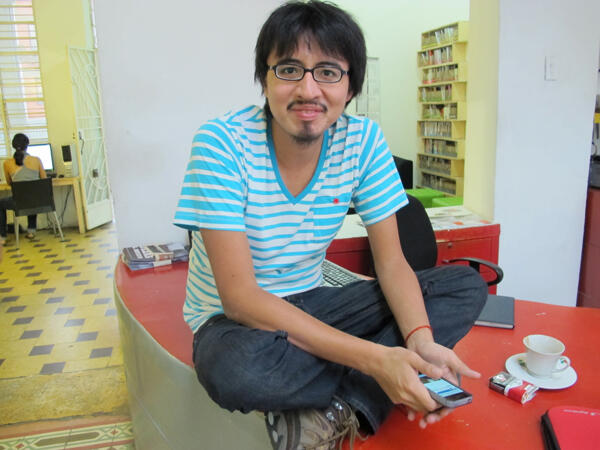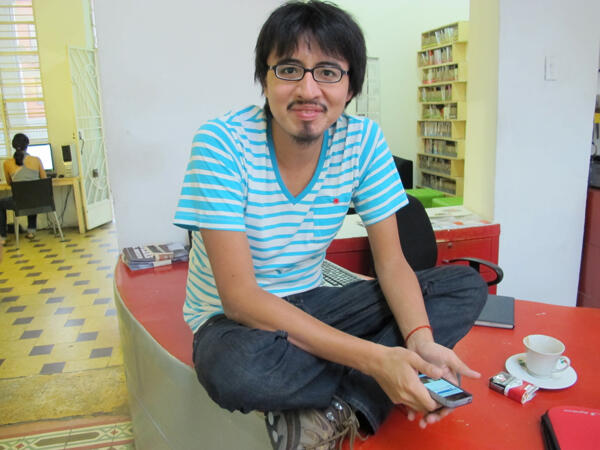Miguel López in Conversation with Cecilia Fajardo Hill
C.F.: I’d like you to tell us about your intellectual training and the ideas that appear in your work, which are inserted in fields as diverse as “queer” politics, art and protest, twentieth-century Peruvian art, memory reactivation, and the processes of “historicization” of Latin American art between the 1960s and the 1980s, ideas that are, on the one hand, specific and constitute an archaeology of little researched histories of Peru and Latin America, and that offer, on the other hand, perspectives that disavow traditional art history models and set themselves up as possible spaces of critical re-signification.

M.L.: I feel that I am an autodidact, but I have gone through several schools. I went to university to study literature, but I soon abandoned these studies to go in search of a more eclectic and less conservative training, something that is very difficult in Lima. Then I followed a technical career in photography and graduated as a visual artist. In 2008, I had the privilege of being the recipient of a scholarship that enabled me to participate in MACBA’s (Barcelona) Independent Studies Program, where I was part of a radical pedagogy program camouflaged under the categorization of “Museological Studies”, which was an intersection of Marxist theory, schizoanalysis, political imagination, gender technologies, desire strategies, urban planning and economy. What was most significant for me, however, was the immersion in feminist theory, lesbian theory, queer theory, and an entire horizon of promiscuous political production which was trying to break down the social apparatus of truth production. Together with Beatriz Preciado, we implemented a two-year workshop on trans-feminist historiography, which was a laboratory to think the notions and words we employ in our historiographic operations. Not only the dominant sexuality and gender models were at stake, but also all the fictions of identity that involve us, from the colonial to the heterosexual ones.
C.F.: How has this influenced your specific work on the archaeology of scantily researched histories in Peru and Latin America?
M.L.: All history is fiction, and at the moment of making history (fiction), what I always ask myself is what kind of interventions into the public sphere this may imply. For me, the work carried out by the Transvestite Museum of Peru, a project involving the queer re-writing of the so-called History of Peru promoted as of 2004 by the drag queen and philosopher Giuseppe Campuzano is a decisive referent. I am fascinated by the way in which his cartographies reject identifications and shamelessly resort to fictional concepts to articulate previously unimaginable histories. For example, when he invokes the word “feather” to write a story connecting the apparel of the leader of the Inca Empire, Manco Capac, portrayed in the drawings by the Indian Guamán Poma de Ayala (16th century), with the paintings of winged warriors and apocryphal angels of the Cusco School in the colonial Andean America (18th century) and the glamorous contemporary drag costumes. I find this punk re-writing that perforates time-space and vandalizes the classical model of history and theory delightful. Which brings us back to the performative character of every historical narrative. I envision my work in that way: as a chance to imagine other origins for certain debates. Hence my attention to the residues of history and my obsession with recovering micro-actions, as for example, the interconnection of conceptualism and gender in the work of Teresa Burga (Iquitos, 1935), or the sexual-political performance work of Sergio Zevallos (Lima, 1962), among others.
C. F.: You generally define yourself as a writer, artist and researcher, and you exclude your activity as curator. Could you elaborate on how you perceive your role in the art world and on the role curatorship plays in your work?
M.L.: As a matter of fact, I am not concerned with the art world but with ways of intervening in the public sphere. I am interested in aesthetics insofar as it is capable of participating in modes of production of subjectivity, of affecting our behaviors. I am seduced by the unpredictable ways in which the visual and the symbolic meddle with desire formation in the social sphere, by the way in which they crystallize a knowledge that seemed impossible to be noticed from traditional disciplines. I am fascinated by the hybrid dimension of things, by their unclassifiable condition, by the inter, the trans… What we understand as curatorship is a chance to experiment with all of this. And in general I prefer not to define myself, I see myself more as a body that sets things in motion.
C. F.: I’m surprised at the fact that in spite of your training as an artist and of your curatorial work you should refer to art in terms of images, the visual and the symbolic, whose action always takes place in the social field. But do you also consider it possible to refer to it based on its specificity within the art system?
M.L.: The art system is a part of the social field and it may function as a seismographer of greater displacements, with the advantage that it sometimes allows a stronger media impact. For example, the inclusion in the Museum of Art of Lima of the work of Sergio Zeballos, an artist who displayed strategies of religious transvestism to highlight in the 1980s and against all consensus, that the origin of political violence had a heteronormative sexual matrix, was not only a blow against art history, from which he was expelled, but also an opportunity to open up a framework for public discussion on the urgent need for a sexual cooperation that might broaden the notion of democracy and question a terrible morality that daily expels a series of bodies considered abnormal.
C.F.: I share your approach to resorting to art as a form of social and political intervention that may alter the visibility per se as well as certain dominant dichotomies that mediate, in a contingent way, the interpretive exercises. But what place do you assign to an art of aesthetic research, whose value resides rather in another form of cognitive poiesis ?
M.L.: Poetry and play have a fundamental role in all this. I think all aesthetic research or creative process allows us always to imagine the world in a different way, and in this sense I value them as a chance to put place in parenthesis the pragmatic models of knowledge that govern everyday life. Being able to go a little beyond the functionalist senses, or of the meanings instituted by governmental, social or religious forces, makes it possible to imagine other uses for language and things, and that is per se a political gesture. We should also inquire into the ways in which these gestures and objects appear in the world and how they participate in the public sphere. I cannot, however, deny my fascination for decidedly utopian projects that dare imagine other models of public sphere and shared existence, whether they be activist or obsessively formalist.
C.F.: And how do you perceive the way in which art inserts itself in consumerist society and in the market?
M.L.: I think that the market is a dissemination channel that may make it possible to counteract certain cultural power and domination maps. But just like the market circuits construct a type of visibility, there are other less perceptible routes that open up new displacements. I am interested in observing the micro-histories and their capacity to forge alliances, even based on failure. In fact, the idea of failure itself interests me: alternatives for the models of success which are habitually hetero-normative or linked to already legitimized methods of knowledge production. Hence, perhaps, my inclination for peripheral archives and certain minor theory: ridiculed concepts, forgotten materials, sick and persecuted bodies, or hybrid or promiscuous experiences that were once illegible.
C.F.: I would like you to comment, as a member of the Southern Conceptualisms Network and other collectives, on collaborative work, and perhaps elaborate on some specific project. I think this model is different from the one of the curator working on his/her own, whose voice as an author is individually promulgated.
M.L. Group work has always been the basis of my practice, whether via groups of art students, publication editorial committees, or research collectives. An experience which was very significant for me was being part of La Culpable in Lima between 2006 and 2008; it was an independent space and an artists’ collective. Among other things, we betted on opening the doors once a week to discuss, informally and freely, the production of an invited artist or cultural agent, and that worked in an impressive way. Operating as a collective clearly implies a political position and requires experimental strategies. For example, the work of the Southern Conceptualisms Network is decentralized: we organize ourselves and decide how and with whom we will work. Those nuclei are defined by affinities and urgencies, and our work is always politically based. Having a plural and diverse gaze makes it possible to articulate more complex reflections that elude the easy ways of identity standardization, but also to address in a more open way the precariousness of cultural work and the question of how to render our resources and materials accessible. I think that at a time marked by the logic of scantiness, our work must attempt to reinvent the very notion of value, and seek ways for the knowledge that we produce to be shared and participate in the formation of a critical public sphere.



